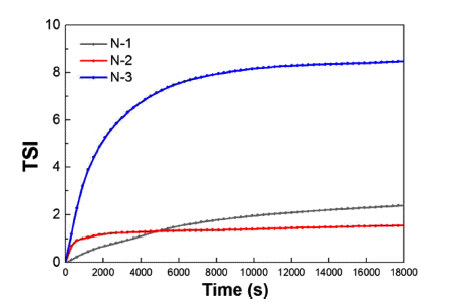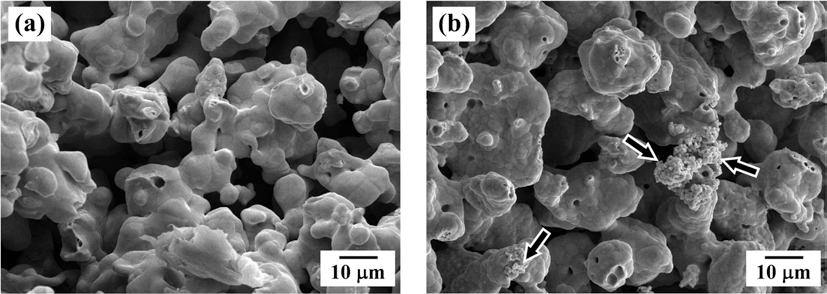Search
- Page Path
- HOME > Search
- [Korean]
- Effect of Surfactant on the Dispersion Stability of Slurry for Semiconductor Silicon CMP
- Hye Won Yun, Doyeon Kim, Do Hyung Han, Dong Wan Kim, Woo-Byoung Kim
- J Korean Powder Metall Inst. 2018;25(5):395-401. Published online October 1, 2018
- DOI: https://doi.org/10.4150/KPMI.2018.25.5.395

- 859 View
- 22 Download
- 1 Citations
-
 Abstract
Abstract
 PDF
PDF The improvement of dispersion stability for the primary polishing slurry in a CMP process is achieved to prevent defects produced by agglomeration of the slurry. The dispersion properties are analyzed according to the physical characteristics of each silica sol sample. Further, the difference in the dispersion stability is confirmed as the surfactant content. The dispersibility results measured by Zeta potential suggest that the dispersion properties depend on the content and size of the abrasive in the primary polishing slurry. Moreover, the optimum ratio for high dispersion stability is confirmed as the addition content of the surfactant. Based on the aforementioned results, the long-term stability of each slurry is analyzed. Turbiscan analysis demonstrates that the agglomeration occurs depending on the increasing amount of surfactant. As a result, we demonstrate that the increased particle size and the decreased content of silica improve the dispersion stability and long-term stability.
-
Citations
Citations to this article as recorded by- Surface Defect Properties of Prime, Test-Grade Silicon Wafers
Seung-Hwan Oh, Hyeonmin Yim, Donghee Lee, Dong Hyeok Seo, Won Jin Kim, Ryun Na Kim, Woo-Byoung Kim
Korean Journal of Materials Research.2022; 32(9): 396. CrossRef
- Surface Defect Properties of Prime, Test-Grade Silicon Wafers
- [Korean]
- Fabrication of Porous Cu by Freeze-drying Process of Camphene Slurry with CuO-coated Cu Powders
- Su-Ryong Bang, Sung-Tag Oh
- J Korean Powder Metall Inst. 2014;21(3):191-195. Published online June 1, 2014
- DOI: https://doi.org/10.4150/KPMI.2014.21.3.191

- 261 View
- 0 Download
- 3 Citations
-
 Abstract
Abstract
 PDF
PDF This study reports a simple way of fabricating the porous Cu with unidirectional pore channels by freeze drying camphene slurry with Cu oxide coated Cu powders. The coated powders were prepared by calcination of ballmilled powder mixture of Cu and Cu-nitrate. Improved dispersion stability of camphene slurry could be achieved using the Cu oxide coated Cu powders instead of pure Cu powders. Pores in the frozen specimen at -25°C were generated by sublimation of the camphene during drying in air, and the green bodies were sintered at 750°C for 1 h in H2 atmosphere. XRD analysis revealed that the coated layer of Cu oxide was completely converted to Cu phase without any reaction phases by hydrogen heat treatment. The porous Cu specimen prepared from pure Cu powders showed partly large pores with unidirectional pore channels, but most of pores were randomly distributed. In contrast, large and aligned parallel pores to the camphene growth direction were clearly observed in the sample using Cu oxide coated Cu powders. Pore formation behavior depending on the initial powders was discussed based on the degree of powder rearrangement and dispersion stability in slurry.
-
Citations
Citations to this article as recorded by- Effect of Freezing and Sintering Condition of CuO-SnO2/Camphene Slurries on the Pore Structure of Porous Cu-Sn
Joo-Hyung Kim, Sung-Tag Oh, Chang-Yong Hyun
Journal of Korean Powder Metallurgy Institute.2016; 23(1): 49. CrossRef - Fabrication of Cu-30 vol% SiC Composites by Pressureless Sintering of Polycarbosilane Coated SiC and Cu Powder Mixtures
Yeon Su Kim, Na-Yeon Kwon, Young-Keun Jeong, Sung-Tag Oh
Korean Journal of Materials Research.2016; 26(6): 337. CrossRef - Synthesis of Aligned Porous Sn by Freeze-Drying of Tin Chloride/camphene Slurry
수룡 방, 승탁 오
Korean Journal of Materials Research.2015; 25(1): 27~31. CrossRef
- Effect of Freezing and Sintering Condition of CuO-SnO2/Camphene Slurries on the Pore Structure of Porous Cu-Sn
TOP
 kpmi
kpmi


 First
First Prev
Prev


